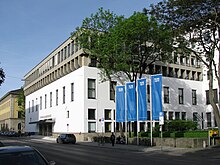TUM Department of Civil, Geo and Environmental Engineering
 | |
| Type | Public |
|---|---|
| Dean | Stephan Freudenstein (Civil and Environmental Engineering) Michael Krautblatter (Geology) |
Academic staff | 45 professors (2020)[1] |
| Students | 3,731 (2020)[2] |
| Location | , , |
| Affiliations | TUM |
| Website | bgu.tum.de |
 | |

The TUM Department of Civil, Geo and Environmental Engineering (TUM BGU) (German: Ingenieurfakultät Bau Geo Umwelt) is a department of the Technical University of Munich, located at its Munich campus. Its main areas of research are civil engineering, environmental engineering and the earth sciences.
Chairs[]
The Department consists of four focus areas and associated members:[1]
- Construction
- Building Physics
- Energy Efficient and Sustainable Design and Building
- Soil Mechanics and Foundation Engineering, Rock Mechanics and Tunneling
- Timber Structures and Building Construction
- Concrete and Masonry Structures
- Metal Structures
- Mineral Construction Materials
- Materials Science and Testing
- Non-destructive Testing
- Mobility & Transportation Systems
- Traffic Engineering and Control
- Road, Railway and Airfield Construction
- Transportation Systems Engineering
- Urban Structure and Transport Planning
- Modeling Spatial Mobility
- Modeling – Simulation – Processes
- Construction Management
- Structural Mechanics
- Computational Mechanics
- Computational Modeling and Simulation
- Hydromechanics
- Real Estate Management
- Engineering Risk Analysis
- Structural Analysis
- Hydro- and Geosciences
- Geothermal Technologies
- Landslide Research
- Hydrogeology
- Hydrology and River Basin Management
- Engineering Geology
- Urban Water Systems Engineering
- Hydraulic and Water Resources Engineering
- Associated Members
- Hydrochemistry
- Strategic Landscape Planning and Management
- Construction Chemistry
- Wood Technology
- Environmental Sensing and Modeling
- Digital Fabrication
- Cartography
- Geodesy
- Geoinformatics
- Land Management
- Astronomical and Physical Geodesy
- Satellite Geodesy
- Geodetic Geodynamics
- Photogrammetry and Remote Sensing
- Remote Sensing Technology
- Signal Processing in Earth Observation
Rankings[]
| University rankings | ||||||||||||||||
|---|---|---|---|---|---|---|---|---|---|---|---|---|---|---|---|---|
| By subject – Global & National | ||||||||||||||||
| ||||||||||||||||
| CHE Ranking 2020 – National | ||||||||||||||||
| ||||||||||||||||
| ||||||||||||||||
In civil engineering, QS ranks TUM within No. 51–100 in the world and No. 1–3 in Germany in 2021, down from No. 47 (first nationally) in the previous year.[3] ARWU ranks TUM within No. 201–300 in the world and No. 2-5 in Germany.[4]
In the environmental sciences, QS ranks TUM as No. 71 in the world and No. 2 in Germany.[5] ARWU ranks TUM as No. 15 in the world and No. 1 in Germany.[4]
The Times Higher Education World University Rankings does not rank individual subjects, though in engineering in general, TUM is ranked 24th globally and 1st nationally.[6]
References[]
- ^ Jump up to: a b "Faculty". TUM Department of Civil, Geo and Environmental Engineering. Retrieved 23 December 2020.
- ^ "TUM Facts & figures". Technische Universität München. Retrieved 22 December 2020.
- ^ Jump up to: a b "QS World University Rankings by Subject 2021: Engineering - Civil & Structural". QS World University Rankings. Retrieved 5 March 2021.
- ^ Jump up to: a b c d "ShanghaiRanking's Global Ranking of Academic Subjects 2021". Academic Ranking of World Universities. Retrieved 28 May 2021.
- ^ Jump up to: a b "QS World University Rankings by Subject 2021: Environmental Sciences". QS World University Rankings. Retrieved 5 March 2021.
- ^ Jump up to: a b "World University Rankings 2021 by subject: engineering". Times Higher Education World University Rankings. Retrieved 9 January 2021.
- ^ "Studying Civil Engineering in Germany". CHE University Ranking. Retrieved 31 December 2020.
- ^ "Studying Geoscience in Germany". CHE University Ranking. Retrieved 31 December 2020.
- Technical University of Munich